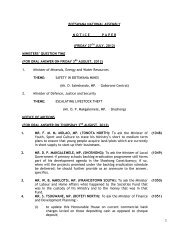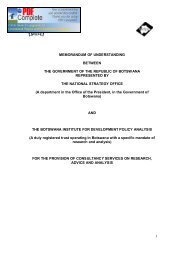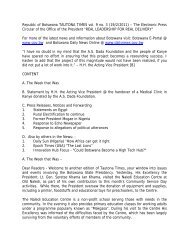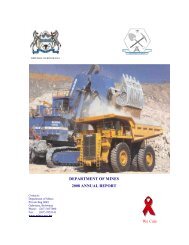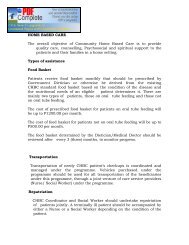Roads Department - Government of Botswana
Roads Department - Government of Botswana
Roads Department - Government of Botswana
You also want an ePaper? Increase the reach of your titles
YUMPU automatically turns print PDFs into web optimized ePapers that Google loves.
<strong>Roads</strong> <strong>Department</strong><br />
2.3.4 Middle East<br />
Fookes & French (1977) with considerable experience <strong>of</strong> soluble salt damage<br />
in the Middle East, produced a paper which considered in detail pavement<br />
damage from natural saline materials. They differentiated clearly between soluble<br />
salt damage due to a high saline water table and that due to saline materials.<br />
The authors defined four relevant zones <strong>of</strong> moisture associated with the<br />
groundwater table, groundwater fluctuations, capillary rise and transient moisture<br />
which can be used to locate pavements away from hazardous ground. A<br />
range <strong>of</strong> soluble salt limits for various types <strong>of</strong> pavement construction, local<br />
moisture regimes and materials was presented. Attention was also drawn to<br />
the possible role <strong>of</strong> various salt combinations.<br />
Tomlinson (1978) also reported the blistering <strong>of</strong> sealed aircraft pavement surfaces<br />
in the Middle East without explanation <strong>of</strong> how it occurred.<br />
Non crystalline salt causes little damage.<br />
2.3.5 North Africa<br />
Following observations <strong>of</strong> salt damaged roads and runway pavements in the<br />
Algerian Sahara, Horta (1985) produced an interesting physico-chemical analysis<br />
<strong>of</strong> the salt damage mechanisms. He ascribed the damage <strong>of</strong> 50mm<br />
thick wearing coarse to the crystallisation <strong>of</strong> halite (NaCl) whiskers or filamentous<br />
crystals and identified some physico-chemical parameters relevant to the<br />
damage mechanism. Attempts to repair a salt damaged surface by recompaction<br />
<strong>of</strong> the blisters completely failed. A new airport was finally built at a different<br />
location. Horta’s observation drew attention to some critical crystal growth<br />
factors, which had not been considered previously in highway work.<br />
2.3.6 North America<br />
Soluble salt damage to bituminous surfaces has also been reported in other<br />
areas. For example, Dunn (1984) reported on the development <strong>of</strong> small domes,<br />
50mm to 100mm in diameter on bituminous road pavements in Virginia, North<br />
America, due to growth <strong>of</strong> pickeringite (magnesium alum) crystals.<br />
These above cases have provided a background to understanding the salt<br />
damage process.<br />
Microscopic sized salt whiskers breaking through<br />
road surfacing. This type <strong>of</strong> crystal causes maximum<br />
damage due to high pressures.<br />
The existing salt limits do not account for upward<br />
migration <strong>of</strong> salts and should, in general,<br />
not be used.<br />
2.4 International Experience on Salt<br />
Damage, Limits and Preventative<br />
Measures<br />
Various recommendations <strong>of</strong> maximum salt content in highway materials have<br />
emerged from the above studies. These recommendations are detailed in<br />
Appendix A. These salt limits are generally based on local experience <strong>of</strong> salt<br />
types and pavement design in other parts <strong>of</strong> the world. They also lack any<br />
detailed understanding <strong>of</strong> salt migration and other influencing factors.<br />
These salt limits should not be applied in <strong>Botswana</strong>. They are given in this<br />
guideline only for general understanding <strong>of</strong> the levels <strong>of</strong> salt content that can<br />
cause damage.<br />
16 Chapter 2<br />
Guide to the Prevention and Repair <strong>of</strong> Salt Damage to <strong>Roads</strong> and Runways<br />
Occurrence and Characteristics




